Silk, the cloth which dreams are made of
Silk is beyond comparison: luxurious and elegant – pleasant to the touch and breathable – it warms in the cold and cools in the heat. .
This unique natural fibre is obtained from the cocoon of the Mulberry moth. For more than 1,000 years these moths have been bred in East Asia and more recently also in southern Europe for the purpose of obtaining silk thread. The silkworm cocoon is made up of a single 3,000 metre long silk thread. However, only some 800 metres of this thread can be reeled as a continuous thread. The filament silk – “Grège” obtained in this way, is the raw material for the precious silk textiles to be found at the Haus der Seidenkultur. What remains of the cocoon is processed to spun yarn – the longer fibres to schappe silk and the shorter fibres to spun silk.
Pamper yourself with this unique, magnificent, smooth fibre and enjoy the incomparable quality of the products made of grège silk. The designs are based on the patterns which used to be woven on the wooden Jacquard looms in the Hubert Gotzes weaving shop for ecclesiastical garments, now Haus der Seidenkultur.
Please have this high-quality reproduction of age-old craftsmanship professionally cleaned. Do not wash it yourself.
By purchasing this stylish product made of pure silk you are helping to preserve this unique example of textile history for future generations.
This is one of the designs produced by the Hubert Gotzes weaving factory for ecclesiastical textiles established in Krefeld in 1905. Here at the factory ecclesiastical vestments, that is to say priests’ robes, and other textiles for use in the church, were produced from the precious silk cloth. Right up to the beginning of the 19th century, it was seldom that textiles were produced exclusively for the church. Robes were tailored from secular textiles but patterns were chosen which also had significance in the symbolic language of the Christian church. The ear of corn which we use is just such a symbol because it is a gift of nature and a present from God; it gives us our daily bread. The ear of corn reminds us of the transubstantiation (transforming) of bread into the body of Christ during Holy Mass (Catholic theology). The models for this pattern are the flower patterns popular in the 18th and 19th centuries. Thanks to modern technology, we can reproduce this historic pattern for you. This product is made of pure filament silk. The design is based exclusively on traditional, historic patterns. A few years ago this pattern was still being manually woven on these premises on wooden Jacquard hand-looms which were up to two hundred years old. Please do not wash it by hand but have it professionally cleaned. Through your purchase you are not just acquiring a stylish pure silk item. You are also helping to preserve our gem for future generations. We wish you a great deal of pleasure with your scarf or tie.
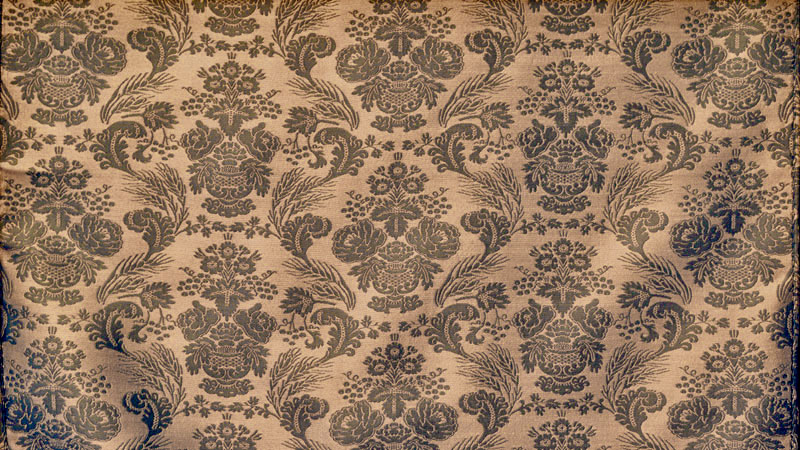
We wish you a great deal of enjoyment from your silk tie. This product is made of pure filament or grège silk. The design is based exclusively on traditional, historic designs. A few years ago they were still being made by hand at the company on wooden Jacquard looms which are up to two hundred years old. Please do not wash the tie by hand but have it professionally cleaned. The Arabesque pattern Arabian influences largely characterise the Arabesque pattern. Motifs from the plant world are artistically interwoven with stylised fantastic animals and in some cases intertwined to form an ornate design. The company Hubert Gotzes replaced the wave-like, parallel curved lines containing kufic characters between the individual pattern elements with floral garlands. Such patterns referred to as Arabesques were the speciality of Moslem master craftsmen and were for a long time also considered standard for their Christian successors. It is striking to note the analogies between the Arabesque patterns and the floor designs in the mosques and palaces built in southern Spain during the reign of the Moors and the painted ornaments in the Alhambra. During the reign of the Moors in Granada in the 13th century, silk weaving flourished at a high level and could definitely compete with Italian silk production. Silk – the cloth which dreams are made of – Is not just incomparably beautiful and elegant, it has a very special feel. Like wool and Cashmere, silk is an animal product. The high quality thread is obtained from the cocoon of the silk moth which is bred for this purpose.Although the caterpillar spins itself into a cocoon of up to 3000 m in length, it is only possible to unwind a thread measuring approx. 800 m. This filament or grège silk is the basis of the most precious silk cloth. The less valuable remains of the cocoons are usually spun in short-fibre form into coarse silk or flock silk.Why not spoil yourself with this unique, magnificent and smooth natural fibre: silk is light-weight and kind to the skin, it warms when it is cold and cools when it is hot. It breathes, is highly elastic and yet very tear resistant. The magnificent sheen and the pleasant appearance of silk are complemented by its high strength.
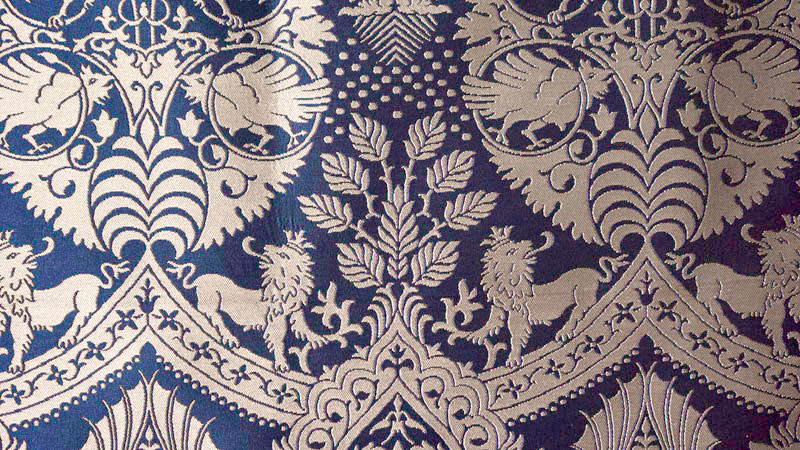
This is one of the designs produced by the Hubert Gotzes weaving factory for ecclesiastical textiles established in Krefeld in 1905. Here at the factory ecclesiastical vestments, that is to say priests’ robes and other textiles for use in the church, were produced from precious silk cloth. The model for this pattern is to be found on Byzantine silk dating from the 11th century. A golden yellow cope from the Brauweiler monastery, the so-called St. Bernhard cope is decorated with this pattern. According to the legend, St. Bernard of Clairvaux wore this cope when he preached in the Brauweiler monastery in 1147 where he urged the believers to join the second crusade. The motif was, however, also familiar in the 11th century because it can be found on the cover of a manuscript dating from this period. A pair of eagles facing one another is to be seen in the circular areas arranged in rows on both sides of the tree of life. Stylised climbing plants surround the circular motifs. There are small circular disks where they meet. Round rosettes provide the motif in the corners. This product is made of pure filament silk. The design is based exclusively on traditional, historic patterns. A few years ago this pattern was still being manually woven on these premises on wooden Jacquard hand-looms which were up to two hundred years old. Please do not wash it by hand but have it professionally cleaned. Through your purchase you are not just acquiring a stylish pure silk item. You are also helping to preserve our gem for future generations. We wish you a great deal of pleasure with your scarf or tie.
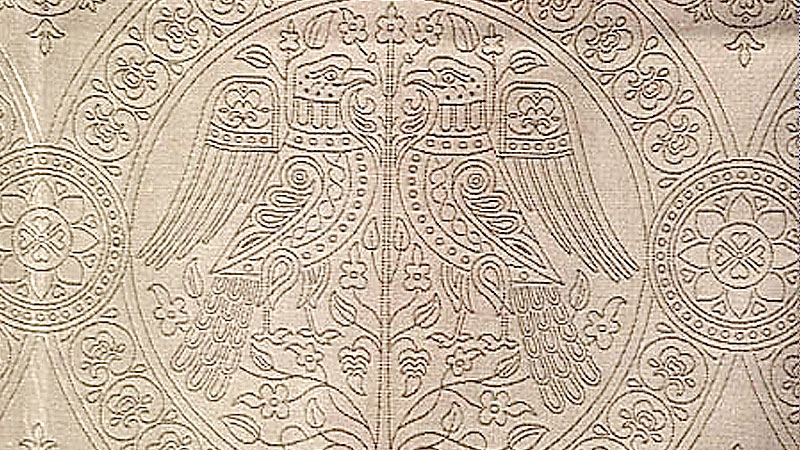
This pattern belongs to the historic Hubert Gotzes weaving company. The appropriate point paper design is kept in the archives. It goes back to the famous “Elephant Cloth” from the shine of Charlemagne. The original material is regarded as being one of the most impressive examples of artistic silk weaving at the time. Produced in the Byzantine Empire – probably for the emperor’s court there, it is thought that the original cloth arrive in the Occident as a gift. An imperial gift because the elephant as one of the strongest animals on earth symbolises the ruler. When the German Emperor Otto III had Charlemagne’s tomb in Aix-la-Chapelle opened in the year 1000, he wrapped the mortal remains of his predecessor in the magnificent cloth. That is how the precious silk cloth has endured the centuries. When the shrine was opened again several times in the 19th and 20th centuries, the impressive pattern was recorded at first in a drawing and later photographed. That is also how it reached Krefeld. Whilst the original motif is some 80 cm in diameter, the variation produced at the beginning of the 20th century is just under 30 cm. The configuration of the motif with the elephant in a circle is also new. In the original, the elephants are standing opposite one another and in strict rows one above the other. Another 20th century variant depicts the elephants in rows but the direction in which they face alternates, in one row the elephants look to the left and in the next to the right. The version which the Haus der Seidenkultur/the historic Hubert Gotzes weaving factory for ecclesiastical vestments brought out in 2004 shows a different possible motif configuration. A further version was brought out in 2008. This product is made of pure filament silk. The design is based exclusively on traditional, historic patterns. A few years ago this pattern was still being manually woven on these premises on wooden Jacquard hand-looms which were up to two hundred years old. Please do not wash it by hand but have it professionally cleaned. Through your purchase you are not just acquiring a stylish pure silk item. You are also helping to preserve our gem for future generations. We wish you a great deal of pleasure with your scarf or tie.
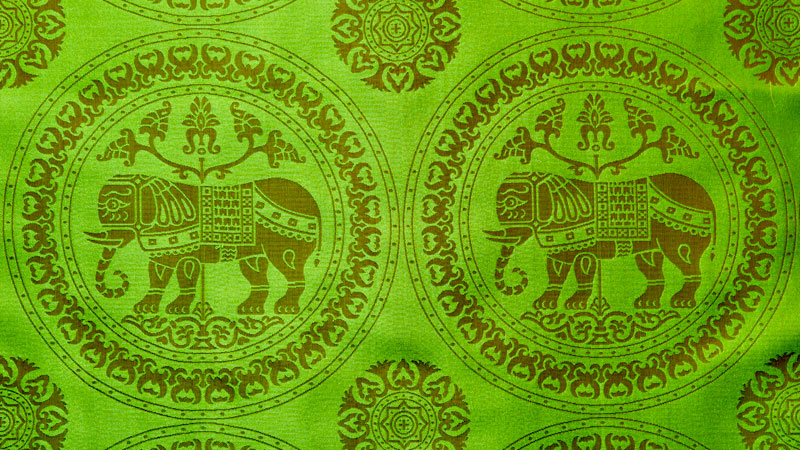
The gondola pattern essentially combines two recurrent characteristic elements offset against one another. In the foreground it depicts a boat resembling a gondola being steered by a falcon with a bell. Passenger in the boat is a dog or a domesticated panther. This hunting scene is typical of Italian lampas fabric dating from the 14th and early 15th centuries. The gondola glides over spiral-like waves on which three ducks or swans are swimming. The background element is a pomegranate tree, the crown of which extends into a symmetric palmette. This pattern may refer to the legend of Torpes of Pisa who was an official in the service of Emperor Nero. During a ceremony in honour of the goddess Diana, Torpes declared that he believed in the one Christian God. Thereupon Emperor Nero had him tortured and beheaded. The corpse of the martyr and saint was placed in a rotten boat together with a dog and a cockerel and it drifted down the river Arno to the Tyrrhenian Sea. According to Provençal tradition Torpes‘ corpse was washed up on the French coast near to the place which was later to become St. Tropez , taking its name from St. Torpes. Today the gondola pattern provides the logo for the German Textile Museum in Krefeld. The museum owns a fragment of the original pattern repeat which has the inventory number 01981. We wish you much pleasure with your scarf or necktie.

This is one of the designs produced by the Hubert Gotzes weaving factory for ecclesiastical textiles established in Krefeld in 1905. Here at the factory, ecclesiastical vestments, that is to say priests’ robes, and other textiles for use in the church, were produced from precious silk cloth. The ornament form in the design was developed from the pomegranate which served as a motif for textile design in antiquity. The pomegranate is the symbol for fertility, love, life and immortality due to the abundance of seeds and its brilliant red colour. In eastern Europe, the pomegranate was a favoured motif amongst bobbin lace-makers. In the 15th century the pomegranate design was incorporated in brocades and damasks in the velvet weaving manufactories in Venice and proved very popular. This product is made of pure filament silk. The design is based exclusively on traditional, historic patterns. A few years ago this pattern was still being manually woven on these premises on wooden Jacquard hand looms which were up to two hundred years old. Please do not wash it by hand but have it professionally cleaned. Through your purchase you are not just acquiring a stylish pure silk item. You are also helping to preserve our gem for future generations. We wish you a great deal of pleasure with your scarf or tie.
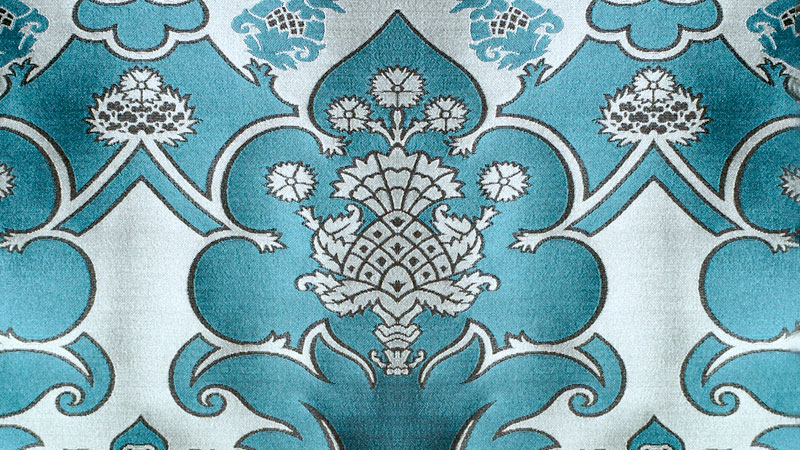
As the story goes, although it is not historically documented, the town of Krefeld was founded on a crow field. The name Crow Pattern is most probably attributable to a former designation of Krefeld, e.g. Krinfelde, Creinvelt, Crenevelt oder Creyvelt. It was therefore logical to develop a crow as a symbol and advertising emblem for the town of Krefeld. We now reproduce this historic pattern on pure silk scarves and ties as a reminder of Krefeld of the past. This product is made of pure filament silk. The design is based exclusively on traditional, historic patterns. A few years ago this pattern was still being manually woven on these premises on wooden Jacquard hand-looms which were up to two hundred years old. Please do not wash it by hand but have it professionally cleaned. Through your purchase you are not just acquiring a stylish pure silk item. You are also helping to preserve our gem for future generations. We wish you a great deal of pleasure with your scarf or tie.
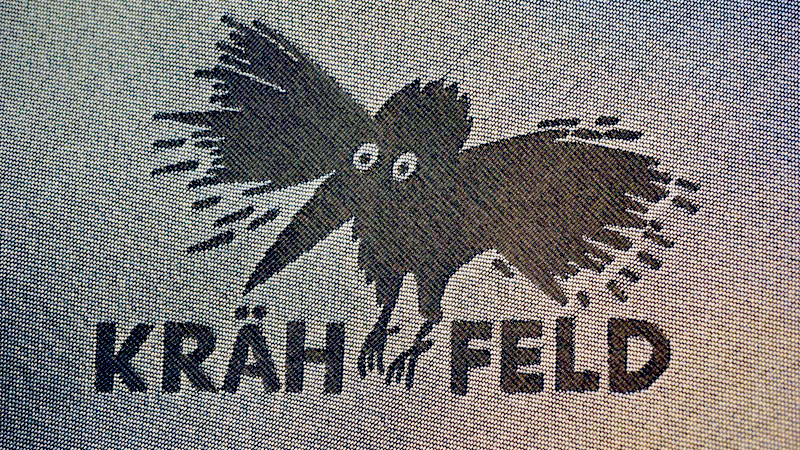
The motif arranged in a network of hexagonal sections shows two tethered stags standing opposite to one another on a floral background. Above them is a band of cloud with a corona and two birds of prey opposite to one another. The individual sections are surrounded by wide ornamental bands with a floral pattern. The stag is an ancient symbol well-known in the Christian Church depicting the God loving soul or the soul of those who wish for calm and peace (documented in the Bible in Psalm 42, verse 1: “As the stag pants for flowing streams, so pants my soul for you, O God”. The stag already played an important role in the ecclesiastical robes of the 13th and 14th centuries. The oriental influence on pattern design at the time can be clearly seen in the fine imaginative design of the animal motifs and the type of ornaments chosen. In the Krefeld ecclesiastical textiles market of the 19th and early 20th centuries, the stag pattern was one of the most popular designs and was woven in every imaginable colour combination and weaving technique. The Hubert Gotzes silk weaving and ecclesiastical textiles factory produced splendid brocade, gold brocade and velvet cloth with this motif. Today the appropriate original point paper designs (design nos. 220, 170 and 320) and the Jacquard punch cards can be found in the museum’s archives. Therefore in principle it is still possible today to weave the stag pattern on one of our 100-year-old Jacquard handlooms. By purchasing this item you are not just acquiring a stylish, pure-silk product, you are also helping to preserve our treasure for future generations. We wish you much pleasure with your scarf and/or necktie.
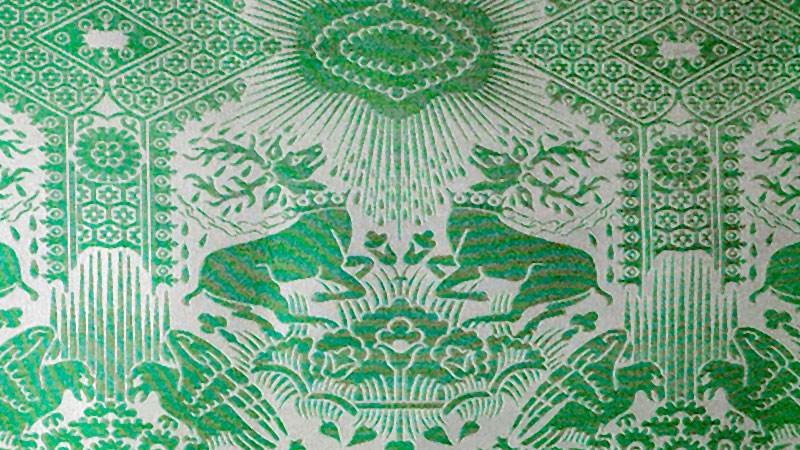
This is one of the designs produced by the Hubert Gotzes weaving factory for ecclesiastical textiles established in Krefeld in 1905. Here at the factory ecclesiastical vestments, that is to say priests’ robes, and other textiles for use in the church, were produced from precious silk cloth. Right up to the beginning of the 19th century, it was seldom that textiles were produced exclusively for the church. Robes were tailored from secular textiles but patterns were chosen which also had significance in the symbolic language of the Christian church. The circle is one of the oldest, if not the oldest symbol used by mankind. As early as the Neolithic period, ceremonial gathering places were arranged in circular shape (Stonehenge in southern England). Round cup marks are made in rocks. The solar disc and the full moon are the most striking circular objects in nature and people worshipped them like gods. In the 3rd and 4th centuries A.D., the cloth woven by the Copts in Egypt was decorated with a circular pattern. Silk cloth was also woven with this pattern in Persia. These textiles could well have served as the pattern for the textiles with large circular patterns which were laboriously woven from precious silk in the Byzantine Empire at the end of the first millennium. The circle symbolises perfection. It is the symbol for an ideal order. Integrity and balance. It has no beginning and no end (eternity). It is therefore particularly appropriate as a symbol of the divine which is why the Christian church has taken over this symbol for their liturgical textiles. This product is made of pure filament silk. The design is based exclusively on traditional, historic patterns. A few years ago this pattern was still being manually woven on these premises on wooden Jacquard hand-looms which were up to two hundred years old. Please do not wash it by hand but have it professionally cleaned. Through your purchase you are not just acquiring a stylish pure silk item. You are also helping to preserve our gem for future generations. We wish you a great deal of pleasure with your scarf or tie.
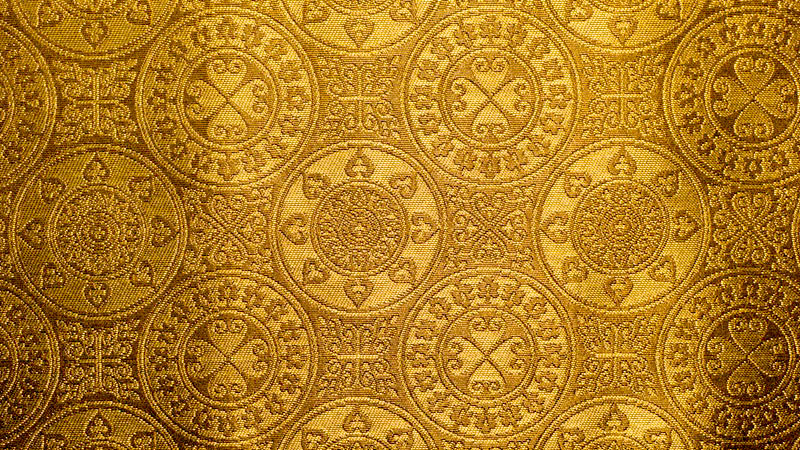
This is one of the designs produced by the Hubert Gotzes weaving factory for ecclesiastical textiles established in Krefeld in1905. Here at the factory ecclesiastical vestments, that is to say priests’ robes, and other textiles for use in the church, were produced from precious silk cloth. The pattern repeat comprises two rows. In the first row there is a pair of male lions in a heart-shaped motif on the right-hand and left-hand side of a flower arrangement. The heads of the animals are turned away from each other. Between the motifs is a vase containing 5 pomegranates. In the second row there is a vase containing 3 carnation-type flowers above the pomegranates. On either side there is a bird with the body of a goose, although the feather headdress is more reminiscent of a peacock. Large tendrils bear five heart-shaped leaves which surround the area containing the birds. The models for this pattern are to be found in 15th century Italy. As it was not until the 19th century that textiles were woven specifically for liturgical use, silk cloth intended for secular use was used to make ecclesiastical vestments. Preference was given to patterns whose symbolism also had a sacral significance. For example, the lion, king of the animals, became the symbol for the power and glory of God. The lion was also the heraldic animal of the House of Judah (Genesis 49:9-10) and consequently of the Jewish kings since David, the ancestors of Jesus Christ. (Matthew 1,1-17). This product is made of pure filament silk. The design is based exclusively on traditional, historic patterns. A few years ago this pattern was still being manually woven on these premises on wooden Jacquard hand-looms which were up to two hundred years old. Please do not wash it by hand but have it professionally cleaned. Through your purchase you are not just acquiring a stylish pure silk item. You are also helping to preserve our gem for future generations. We wish you a great deal of pleasure with your scarf or tie.
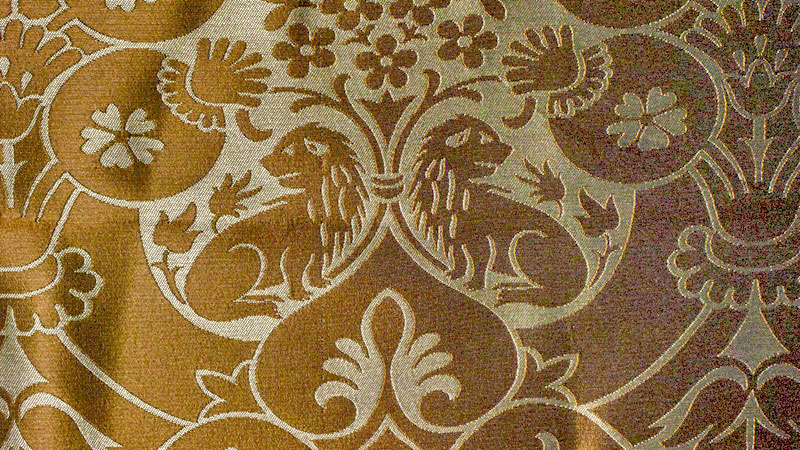
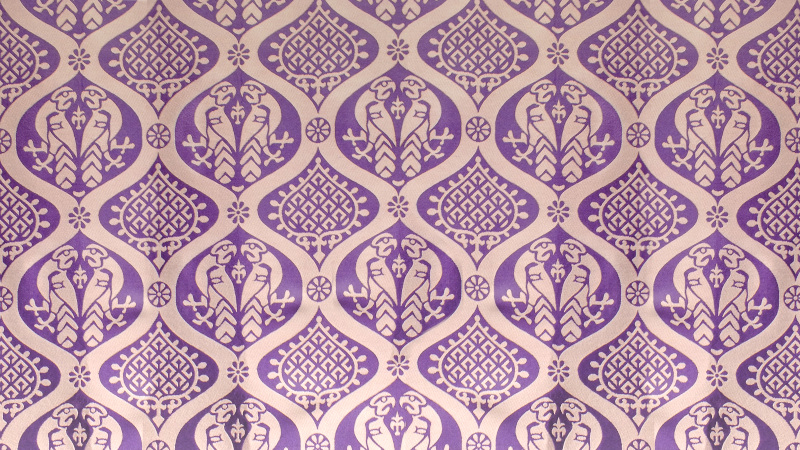
Das Motiv ist in einem Spitzovalnetz aus gegenläufigen Wellenranken angeordnet, deren Berührungspunkte mit kleinen, achtfach gelappten Rosettenblüten versehen sind.
In den einzelnen Feldern befinden sich reihenweise, abwechselnd gegenständige papageienartige Vogelpaare und herzförmige geschuppte Blattmotive.
Die Musteranordnung und einzelne Musterelemente, wie die achtfach gelappten Rosettenblüten, sind typische Merkmale für italienische Seiden des 13.Jahrhunderts.
Ein Abschnitt eines entsprechenden italienischen Samitum-Gewebes (Halbseiden-Gewebe: Gewebe aus Seide und Leinen) befindet sich im Besitz des Deutschen Textil-Museums Krefeld.
In der frühen Zeit sind Samite, die auf byzantinische Vorbilder zurückgehen, für Venedig charakteristisch. Das Musterelement der gegenständigen Papageien findet sich zu der Zeit auch auf Stoffen aus Lucca.
This is one of the designs produced by the Hubert Gotzes weaving factory for ecclesiastical textiles established in Krefeld in1905. It can still be seen on loom no. 6 in the weaving workshop today. Here at the factory ecclesiastical vestments, that is to say priests’ robes, and other textiles for use in the church, were produced from the precious silk cloth. Right up to the beginning of the 19th century, it was seldom that textiles were produced exclusively for the church. Robes were tailored from secular textiles but patterns were chosen which also had significance in the symbolic language of the Christian church. The paradise pattern is arranged symmetrically with pairs of birds of prey facing one another under a sun motif. The pairs of birds are each separated by an elaborately stylised palm tree, in whose fronds there is a nest. Therein grows a tree with a single flower in the centre and wide-spread branches under which there is a pair of swans facing one another. The pattern belongs to a group of textiles inspired by Chinese motifs which were produced in the 14th century in various centres for silk weaving in Italy such as Lucca, Venice and Florence. Despite the obvious heathen symbols, these patterns found their way into the symbolism of the church. The crescent moon was ignored and the bird was interpreted as an eagle. This, the most powerful bird in the sky, was equated with Christ, the sun regarded as the light of the enlightenment. The pair of swans represented constant faithfulness. Therefore it was possible to make ecclesiastical vestments and altar hangings from material bearing this pattern. In Krefeld, the pattern was produced exclusively as silk cloth based on the colour canon of the church, i.e. in the five colours red, white, black, green and purple, just as the historic model was. The pattern could also be woven tone in tone or in two colours by also using gold thread. This product is made of pure filament silk. The design is based exclusively on traditional, historic patterns. A few years ago this pattern was still being manually woven on these premises on wooden Jacquard hand-looms which were up to two hundred years old. Please do not wash it by hand but have it professionally cleaned. Through your purchase you are not just acquiring a stylish pure silk item. You are also helping to preserve our gem for future generations. We wish you a great deal of pleasure with your scarf or tie.
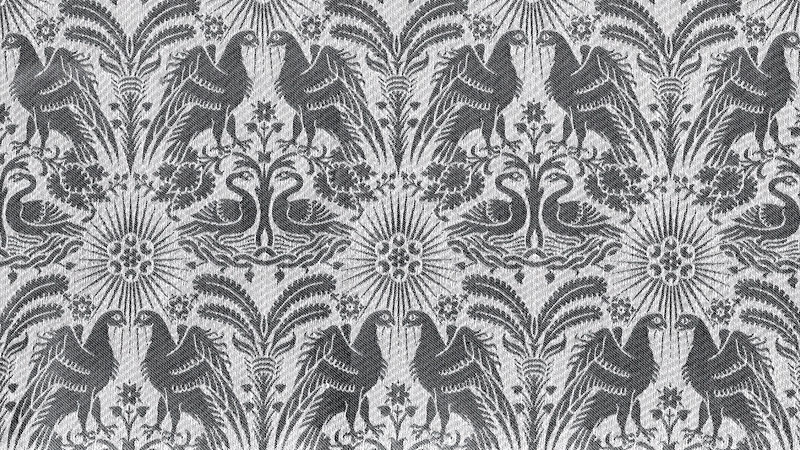
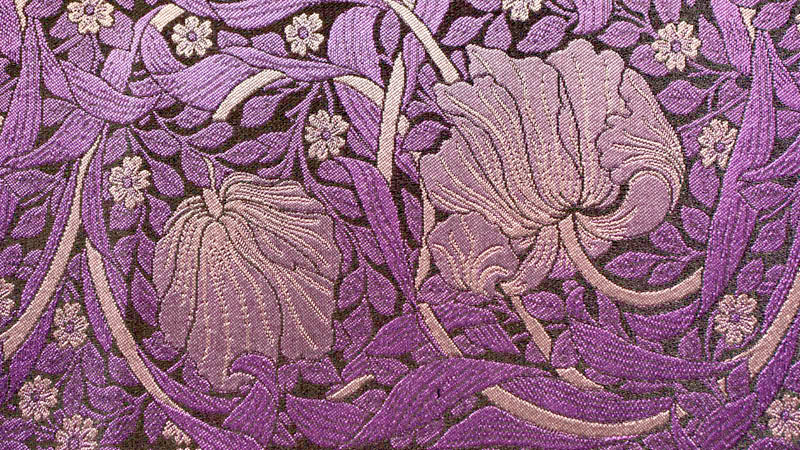
The Pimpernel pattern was designed for a wall covering in 1876 by the English artist William Morris (1834 – 1896). The plant which gives it the name covers the background with thick foliage and five-petal flower heads. Tulip stems are woven in between and the large yellow and white flowers incline to the left and right.
The pattern is built-up asymmetrically as is the case in mediaeval textiles on which William Morris liked to base his designs but it is reminiscent of Art Nouveau. The point pattern maker, Günter Göbels, did the necessary background work to enable this pattern to be woven on modern Jacquard looms. The Hauser Group, Krefeld, donated ties with this pattern to mark the centenary of the Hubert Gotzes weaving factory for ecclesiastical textiles.
